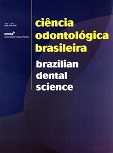Avaliação in vitro de propriedades físico-químicas de cimentos de ionômero de vidro convencionais, após adição de própolis e antibióticos
DOI:
https://doi.org/10.14295/bds.2006.v9i1.267Abstract
O objetivo deste estudo foi avaliar o desgaste pela perda de massa após escovação simulada, a liberação de flúor e a resistência à compressão de dois cimentos de ionômero de vidro, um indicado para restaurações convencionais e outro indicado para a técnica de restaurações atraumáticas (ART), com a adição de antibióticos e própolis. Foram confeccionados corpos-de-prova em cimentos de ionômero de vidro (Vidrion R e Vitro Molar), adicionando-se antibióticos (cefaclor, ciprofloxacina e metronidazol) ou suspensão de própolis (30% em álcool de cereais) aos mesmos. A seguir observou-se perda de massa por escovação simulada (n=48), resistência à compressão (n=90) e liberação de flúor (n=60) dos corpos-de-prova. Os dados obtidos foram analisados estatisticamente pelo teste de variância ANOVA e Tukey com nível de significância p < 00,5. Analisando-se os resultados obtidos, verificou-se maior perda de massa após escovação simulada para o cimento de ionômero de vidro (Vidrion) adicionado de antibiótico, em relação ao Vidrion (grupo controle), com diferença estatisticamente significativa. Ocorreu maior liberação de fluoretos no cimento de ionômero de vidro (Vitro Molar) adicionado de antibióticos em relação ao Vitro Molar, com diferença estatisticamente significativa. A resistência à compressão foi menor, com diferença estatísticamente significativa, para o cimento de ionômero de vidro (Vidrion) adicionado de antibióticos e de propolis em relação Vidrion. Ocorreu também, diferença estatística na resistência à compressão entre os cimentos de ionômero de vidro Vidrion e Vitro Molar, com superioridade para o primeiro.Downloads
Downloads
Published
How to Cite
Issue
Section
License
Brazilian Dental Science uses the Creative Commons (CC-BY 4.0) license, thus preserving the integrity of articles in an open access environment. The journal allows the author to retain publishing rights without restrictions.
=================




























